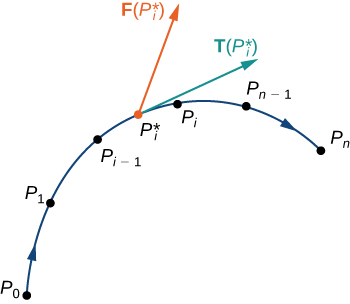| << Chapter < Page | Chapter >> Page > |
Let be a parameterization of C for such that the curve is traversed exactly once by the particle and the particle moves in the positive direction along C . Divide the parameter interval into n subintervals of equal width. Denote the endpoints of by Points P i divide C into n pieces. Denote the length of the piece from P i−1 to P i by For each i , choose a value in the subinterval Then, the endpoint of is a point in the piece of C between and P i ( [link] ). If is small, then as the particle moves from to along C , it moves approximately in the direction of the unit tangent vector at the endpoint of Let denote the endpoint of Then, the work done by the force vector field in moving the particle from to P i is so the total work done along C is

Letting the arc length of the pieces of C get arbitrarily small by taking a limit as gives us the work done by the field in moving the particle along C . Therefore, the work done by F in moving the particle in the positive direction along C is defined as
which gives us the concept of a vector line integral.
The vector line integral of vector field F along oriented smooth curve C is
if that limit exists.
With scalar line integrals, neither the orientation nor the parameterization of the curve matters. As long as the curve is traversed exactly once by the parameterization, the value of the line integral is unchanged. With vector line integrals, the orientation of the curve does matter. If we think of the line integral as computing work, then this makes sense: if you hike up a mountain, then the gravitational force of Earth does negative work on you. If you walk down the mountain by the exact same path, then Earth’s gravitational force does positive work on you. In other words, reversing the path changes the work value from negative to positive in this case. Note that if C is an oriented curve, then we let − C represent the same curve but with opposite orientation.
As with scalar line integrals, it is easier to compute a vector line integral if we express it in terms of the parameterization function r and the variable t . To translate the integral in terms of t , note that unit tangent vector T along C is given by (assuming Since as we saw when discussing scalar line integrals, we have
Thus, we have the following formula for computing vector line integrals:
Because of [link] , we often use the notation for the line integral
If then d r denotes vector
Find the value of integral where is the semicircle parameterized by and
We can use [link] to convert the variable of integration from s to t . We then have
Therefore,
See [link] .
![A vector field in two dimensions. The closer the arrows are to the origin, the smaller they are. The further away they are, the longer they are. The arrows surround the origin in a radial pattern. A single curve is plotted and follows the radial pattern in quadrants 1 and 2 over the interval [-1,1]. It is a concave down arch that looks like a downward opening parabola.](/ocw/mirror/col11966_1.2_complete/m54012/CNX_Calc_Figure_16_02_007.jpg)

Notification Switch
Would you like to follow the 'Calculus volume 3' conversation and receive update notifications?